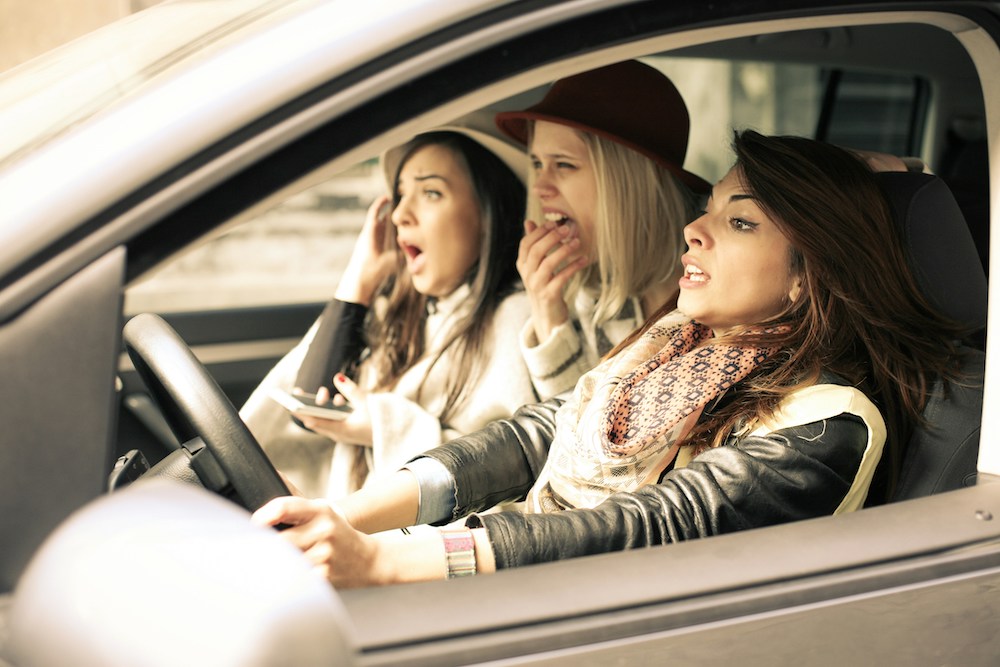There are three areas of communication that modern drivers use to connect with each other on a daily basis: verbal communication , hand gestures, and car-to-car. Know how to effectively communicate on the road and you can keep yourself safe and increase the pleasure of your daily commute.
VERBAL COMMUNICATION
When we think about speaking to other drivers, it is often as a result of road rage. But this is not the only way we verbally communicate. If you are pulled up at a stoplight and the car to the side of you has a flat tire, grab the driver’s attention and inform them of the problem. This can prevent a more disastrous scenario down the road.
If you have been in an accident, it is important to clearly and calmly talk to those involved, especially when injury is present. Assess the situation and verbally communicate your actions and you will decrease the tension of those involved.
Keep your cool and use your words to describe what is going on to injured victims. Let them know that help is on the way.
HAND GESTURES
This is another type of communication that is often associated with road rage, but has many other, friendlier uses.
As mentioned before, getting the attention of another driver is not always initiated with words. Waving to a driver to signal a flat tire, or some other problem, is a commonly accepted practice while driving.
If you have been in an accident and do not have access to road flares, waving your arms above your head is a clear sign of distress. You can use hand gestures and other body language to signal you need someone to stop or to indicate another driver should keep going.
One way people improperly use the hand gesture is to give up their right-of-way. If two cars approach an intersection at the same time, the car to the right has the legal right-of-way. Polite drivers who give the go-ahead gesture are disrupting the flow of traffic.
CAR-TO-CAR COMMUNICATION
As technology advances, so do the safety features in cars. From seatbelts and side-view mirrors to back-up cameras and advanced airbag systems, modern manufacturers are developing safer vehicles. One new technology that is underdevelopment is car-to-car communication.
Some automakers already provide a form of this in their high-end models. Sensors and cameras installed in the vehicles can alert the driver to a car riding in a blind spot or other potentially dangerous situations. These signals can be visual, auditory, or tactile.
The current use of cameras and sensors for car-to-car communication represents a huge step forward in technology. But this technology is still limited. Scientists and auto-makers are developing a similar system that allows cars to “talk” to each other over a wireless network from greater distances.
The goal of this new technology is to allow drivers to not just survive a crash but also to avoid them.
WHAT TO DO IN AN ACCIDENT
If the worst happens and you are in an accident, there are things you can do to minimize injury and help return the flow of traffic around you to normal speed.
The first thing you need to do is turn on your hazard lights. This informs the drivers in your immediate area that there is something wrong with your vehicle and you will need to get over. This also signals your intent to pull over to the person or persons involved in the accident with you.
Once you are on the side of the road, make sure that you and all other parties involved turn off your cars’ engines.
If someone has been injured in the accident, seek immediate help. Call or signal for rescue services as soon as possible.
While waiting for the paramedics to arrive, do not move the injured person unless absolutely necessary. Also, if you were in an accident with a motorcyclist, do not remove the driver’s helmet.
If no injury is detected, and where possible, swap insurance information while you wait for the authorities to arrive. Take pictures of the damage to your vehicle because you may need them as a reference at a later date.
Always have a small safety kit in your car. Some areas where crashes take place are hard to reach, making it difficult for emergency personnel to arrive. If you are prepared for any eventuality, the unexpected will never catch you off guard.
A few items to always keep in your car are:
- A first aid kid
- A heavy blanket
- A flashlight and batteries
- A warning triangle and road flares
- A cell phone charger
- Water
Hopefully, you will never need to use any of these items in an emergency, but it is better to have them and not need them, than to need them and not have them.
By following these methods of driver communication, you drastically reduce your risk of being involved in an auto accident. If you are injured in an auto accident, seek medical help immediately, then contact a legal professional to see what legal options are available to you.

